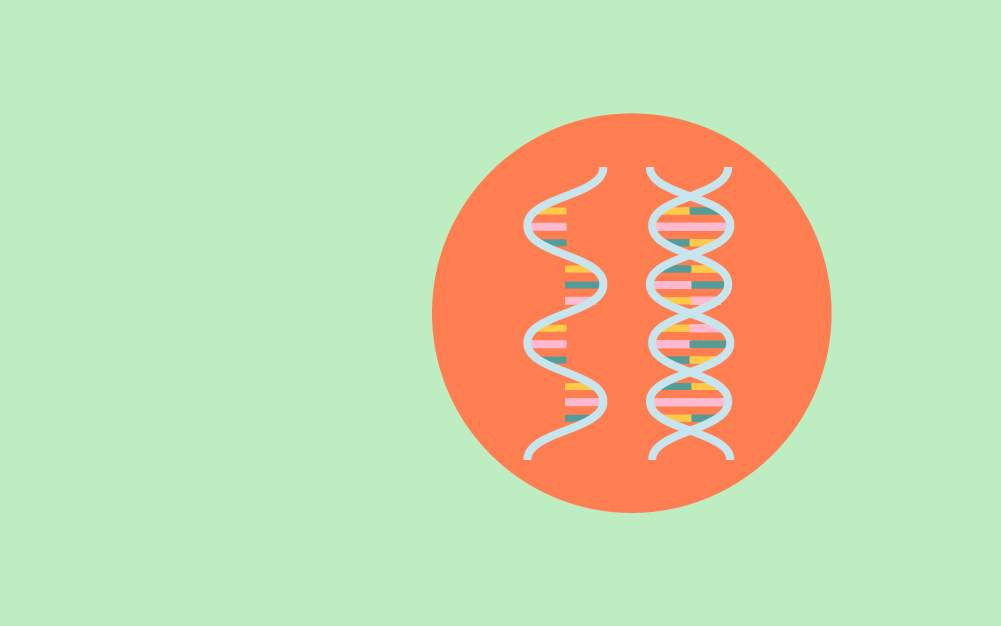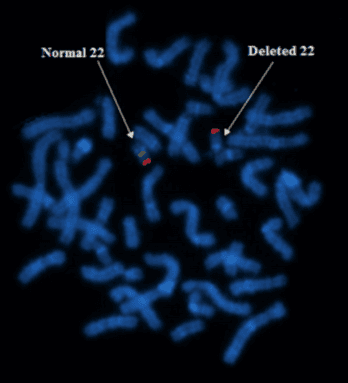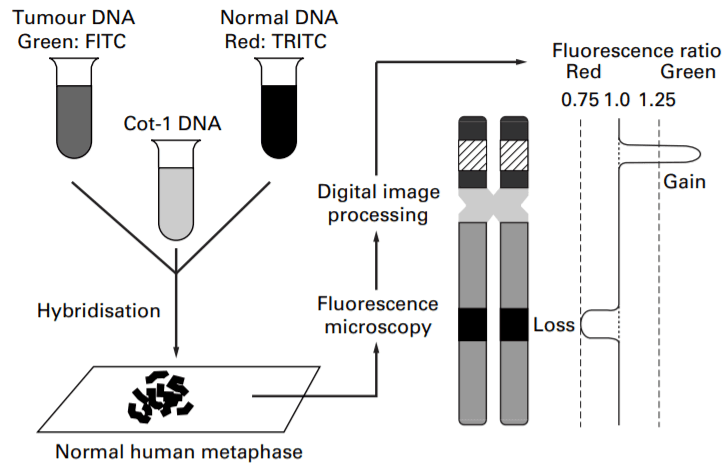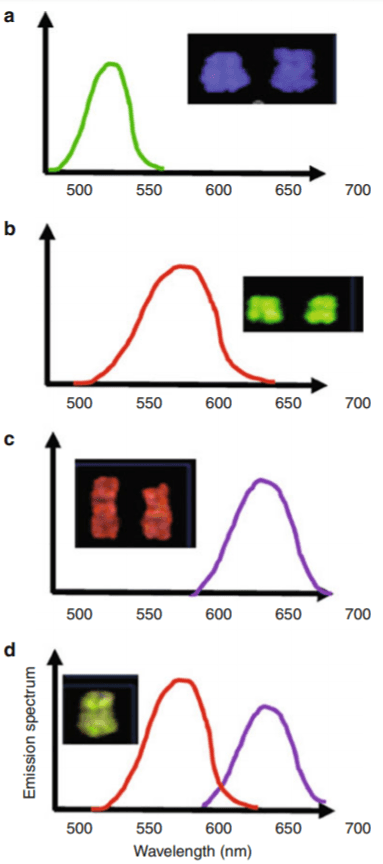

Cytogenetics was introduced in 1900 as a tool to determine the correct number of chromosomes of an organism. Since the 1970s, it has been used to detect clinical syndromes; it helped to understand the chromosomal aberrations and phenotypes associated with it.
Karyotyping was the first cytogenetics tool used to study the characteristics of chromosomes. But, the resolution of this method was not enough to study the precise position and function of a gene in a chromosome. The limitations[7] of karyotyping were: (1) it could only analyze >3 MB of DNA, (2) the process required mitotically active cells, (3) it was difficult to study the complex chromosomal rearrangements, and (4) preparation of slides were required (which made it a time taking process).
Later in the 1980s, molecular cytogenetic techniques were introduced, which brought a different era of analyzing chromosomes with variant colors. This was the first technique to introduce the concept of “in situ hybridization”. It helped the researchers in different ways[7]: (1) by boosting the chromosome mapping strategies, (2) permitted the identification of complex chromosome rearrangements, and (3) helped in the identification of chromosomal aberrations such as translocation, deletion, insertion, and inversion.
Pinkel introduced the Fluorescent in situ hybridization technique in 1986; he used fluorescently labeled probes to analyze the genomic DNA/RNA region for any abnormalities. The labeled probes bind and glow to their complementary regions on the chromosome – this can be observed using a fluorescent microscope. Molecular cytogenetics has paved the way for clinical and research developments by introducing the FISH technique to diagnose and treat abnormalities.
This method is highly efficient over the classic Karyotype technique, as it requires less time (it does not require cell culture) and provides a high-resolution view of the chromosomes. This technique allowed scientists to have a closer look at chromosomal aberrations and to diagnose the abnormalities with more accuracy and precision[7].
Method
DNA probes and target sequences are the two basic elements of FISH.
Probes
The choice of probes depends on the chromosomal regions to analyze. The three main types[7] of probes include:
Mechanism

Figure: The image shows the deletion of chromosome 22 by using the FISH technique. Notice the absence of green color in the chromosome pointed by the arrow on the right-hand side.
Advantages
Limitations
The use of probes (in the FISH techniques) to analyze the chromosomes, requires the pre-knowledge of chromosomal aberration, which makes the analysis a complex process. To overcome this limitation, the FISH technique was modified several times for different diagnostic and research purposes based on the type of specimen to be analyzed or the information needed. Thus, genome-wide screening techniques were introduced, which produced precise and more reliable results compared to the previous techniques. These techniques involve:
The following sections will give a brief description of the modified FISH techniques with their limitations and advantages.
CGH technique helps in the detection of copy number variation in the chromosome of an organism without the need for cultured cells. This technique (in comparison to FISH) is less time-consuming and provides an overview of specific chromosomal regions that have undergone deletion or duplication (which causes pathogenesis). It is more efficient in the analysis of oncogenes/cancer.
Method
CGH involves the labeling of DNA of interest and control samples with two different fluorescent probes. Like, label the test sample (tumor DNA) with green color and the control (normal sample) in the red color. Then, hybridize the metaphase chromosomes with both probes on the slide. The computer algorithm then gives the ratio of fluorophore generated by photometric analysis of the two DNA samples (it measures the ratio of test over the control or reference). The ratio provides an idea of deletion (ratio <1) or duplication (ratio >1) at specific chromosomal loci in examined DNA[11].
Array-CGH is the modified CGH technique. It is a chip-based technology that is less than an inch in size. Thousands of probes are present in a grid on the chip; differently colored test and control samples are mixed in the grid where they compete to bind with the available probes. The procedure and analysis to be done are the same as CGH. But, this technique (array-CGH) is more efficient than CGH, as it can simultaneously analyze large samples and multiple loci of the chromosomes in very less time.

Figure 2: The figure shows the difference between the comparative genomic hybridization (CGH) and array-CGH. Notice how both determine the ratio of fluorophores and predict the gain or loss of a specific chromosomal locus.
Advantages
Limitations
The primedin situ hybridization technique was first used to visualize the difference between the ɑ-satellite region of the two different chromosomes of humans. This technique is more sensitive and faster compared to all the other available FISH techniques[4]. A major difference between both techniques is; that FISH involves the use of labeled probes while PRINS involves the use of unlabeled probes.
Method
This technique involves the use of unlabeled probes. When the unlabeled probes are mixed with the test sample, labeled dNTPs, and DNA polymerase, probes bind with the specific complementary target sequence. After binding with the target sequence, they act as a primer, and a chain elongation reaction is catalyzed by the DNA polymerase (it uses labeled dNTPs) at hybridizing site. The reaction is catalyzed in three primary steps: (1) denaturation, (2) annealing, and (3) elongation. So, only the probe binding at the target site will be labeled.
The use of unlabeled probes in the PRINS technique helps in reducing the background disturbances/signals very efficiently. As only the probe binding to its target sequence will be polymerized and incorporate labeled dNTPs (which will give color to that particular chromosomal region)[4]. Moreover, this technique requires only 5-30 minutes for the reaction to occur. Because of the lesser time of the reaction, the morphology of the chromosome is well preserved.

Figure 3: The image shows the PRINS reaction. The probe which binds at the target sequence act as primer and polymerase chain reaction only occurs at that place.
Advantages
Limitations
Spectral karyotyping (SKY) and M-FISH techniques are very advanced FISH-modified techniques. SKY technique was first introduced by Schröck E et al. in 1996. Both techniques involve the use of multicolor probes; 3-7 differently colored probes are used for single hybridization[6]. The only difference in both techniques is: SKY colors one entire chromosome in only one color whereas M-FISH highlights the regions of a chromosome in a different colored banding pattern. All 24 color combinations (generated from 3-5 differently colored probes) can be observed in the M-FISH technique. Presently, ‘SKY’ is being used to analyze the human, rat, and mouse chromosomes.
The procedures of both techniques are the same except for the software used to analyze the obtained images. That is why, in this section, only one technique – the SKY technique – will be discussed.
Method
Basic steps[10] involved in the SKY technique are given below:

Figure 4: The image on the left-hand side shows how the software analyzes the spectral characteristic to identify chromosomes.
The image on the right-hand side shows DAP I (black and white[A]) stained and fluorochrome stained images [B]. [C] shows the karyotype of chromosomes stained in both (DAPI and fluorochrome) ways.
Advantages
Limitations
Spectral Karyotyping (SKY) Technique
Molecular cytogenetics involve techniques based on the concept of in situ hybridization, such as Fluorescent in situ hybridization (FISH), spectral karyotyping (SKY), primed in situ hybridizations (PRINS), and comparative genomic hybridization (CGH). All these techniques involve the use of labeled probes, except PRINS in which labeled dNTPs (and unlabeled probes) are used instead of labeled probes. These techniques have made research easier and faster by providing reliable results in 1-3 hours and by allowing the analysis of multiple samples simultaneously. All these techniques have vast applications in clinical cytogenetics to diagnose various chromosomal aberrations (macro, as well as micro aberrations). Diagnosis and treatment (which help to develop targeted therapies) of cancer have also become easy since the evolution of these techniques. Molecular cytogenetics colored the world of chromosomes and it is expected that all the limitations will be overcome through the use of combinatorial approaches to these techniques.
